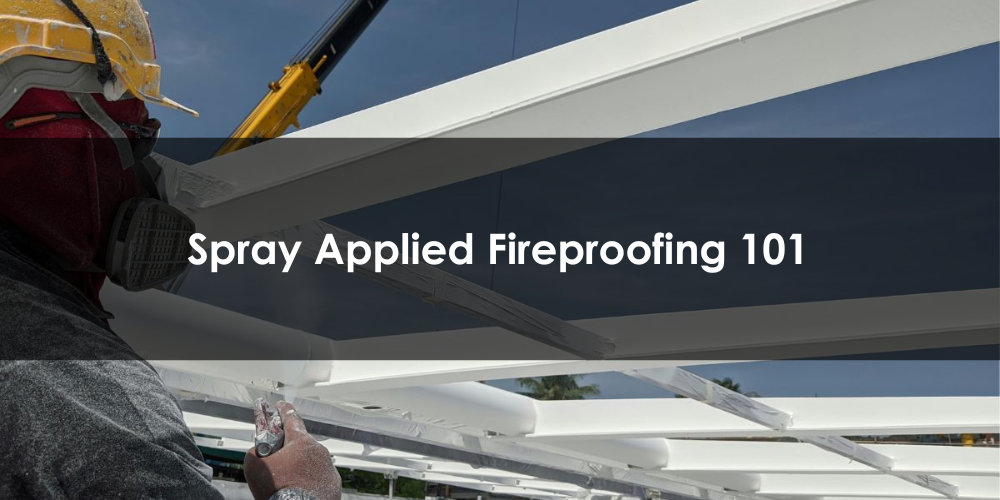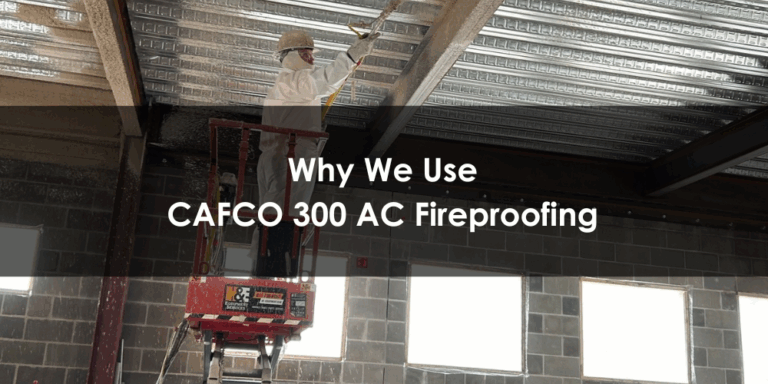
Many commercial and residential buildings, including schools, hotels, apartments, hospitals, stores, and more, are required by law to achieve specified fire ratings designed to ensure the safety of occupants and infrastructure. Fire ratings are governed by international standards such as the International Building Code (IBC) and the National Fire Protection Association (NFPA), and determine the extent to which a building material or assembly can withstand fire exposure before failure or compromise. One of the most reliable and cost-effective methods of achieving the necessary fire ratings for your construction is spray-applied fireproofing, also called sprayed fireproofing or sprayed fire resistive materials (SFRM). In this comprehensive guide, our experts have assembled all the information you may need to know before specifying spray applied fireproofing for your construction project.
How do I know if I need spray applied fireproofing?
Specific fire rating requirements vary based on factors such as building type, occupancy, size, and location–but most commercial construction requires at least a 1-hour fire rating. Certain building elements may be subject to different fire ratings, including walls, doors, windows, ceilings, and structural components (reference IBC tables 601 and 602).
Compliance with fire rating regulations involves rigorous testing and certification procedures, and non-compliance can result in fines, legal liabilities, and even building closure.
What are the different types of spray applied fireproofing?
There are 2 main types of spray applied fireproofing: cementitious fireproofing and intumescent paint.
Cementitious fireproofing is a mix of either gypsum or portland cement, combined with water and sprayed onto the building via a pump. Nettles Construction Solutions uses the CAFCO 300 AC gypsum mix as our standard cementitious fireproofing; however, other mix designs may be used in specific applications, such as when we’re installing fireproofing outdoors or on buildings greater than 75 stories tall.
Once applied, the sprayed cementitious fireproofing dries to create a foam-like texture that has the insulating properties of cement and protects structural steel and concrete from intense heat. After a layer of cementitious fireproofing dries for approximately 24 hours, it can be reapplied over the same area to increase the fire rating. A “bond seal” can be applied over the cementitious fireproofing to darken it and make it less visible.
Intumescent fireproofing is also called intumescent paint, because once dried, it is aesthetically pleasing and looks like a layer of paint. In fire situations, the fireproofing swells (or “intumesces”) to many times its original thickness, insulating and protecting structural steel members from the heat. Intumescent coatings provide a clean, smooth surface and can be finished with a variety of topcoats.
Intumescent fireproofing is also installed via a pump, but the pump is smaller and lighter than what is required for cementitious fireproofing.
How long does sprayed fireproofing last?
Once installed, spray applied fireproofing will provide your building with the necessary fire rating for the entire life cycle of the structure–fireproofing does not weaken with age. If a section of the fireproofing is knocked off during severe weather or renovation, we can use a smaller pump to “patch” the affected area and re-apply the fireproofing.
Fireproofing can also become delaminated from water damage (often due to a leaky roof). In that situation, the fireproofing must be scraped off and reinstalled.
What fire rating does sprayed fireproofing provide?
Based on the thickness of the material, both cementitious and intumescent fireproofing can achieve 1-4 hour fire ratings.
How is sprayed fireproofing installed?
With cementitious fireproofing, Nettles Construction Solutions uses a 4-man crew to batch the material onsite using a mixer and a pump, then spray it on the structure. We can spray multiple layers depending on the fire rating needed, after each layer has approximately 24 hours to dry.
Intumescent fireproofing requires only 2 installers and less equipment, since the pump is smaller and the crew uses gallon buckets of material similar to paint.
How much does spray applied fireproofing cost?
A variety of factors may impact the cost of your project, including the building size, amount of spray applied fireproofing required, geographic location, fire rating, and whether the building is already framed in and protective coverings are required.
How long does it take to install spray applied fireproofing?
The project timeline is highly variable depending on building size and a number of other factors; the average Nettles spray applied fireproofing project takes 8-10 days to complete.
Are there alternatives to spray applied fireproofing?
Fire board, a mineral wool with the appearance of insulation, can be installed in place of spray applied fireproofing to achieve the required fire ratings. It is a more expensive solution, but has aesthetic benefits and is easily paintable.
How do I select a spray applied fireproofing contractor?
Partner with a reliable contractor who has deep expertise in both cementitious and intumescent fireproofing. Your fireproofing partner should adhere to deadlines and budgets, communicate clearly about project updates and delays, and understand the codes and regulations governing your building.
Ask prospective contractors about their memberships or industry associations; for example, members of the National Fireproofing Contractors Association must have a minimum of two years of experience and 20 completed projects.
Want to learn more?
If you have additional questions about spray applied fireproofing, our expert team would love to help you. Get in touch today!




